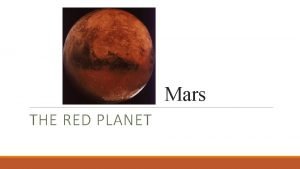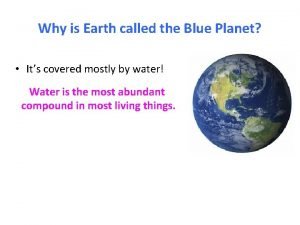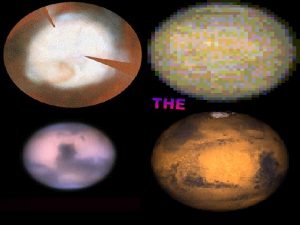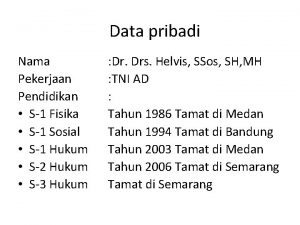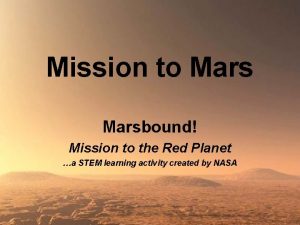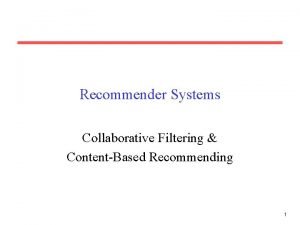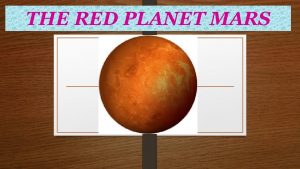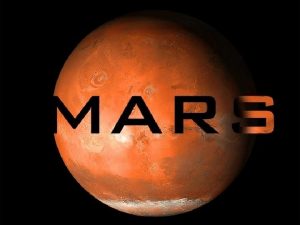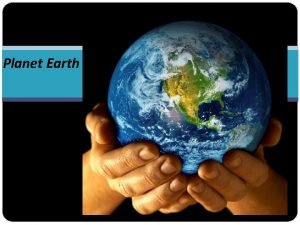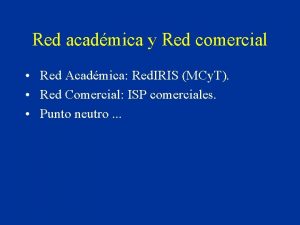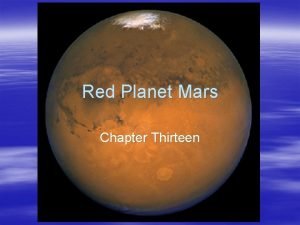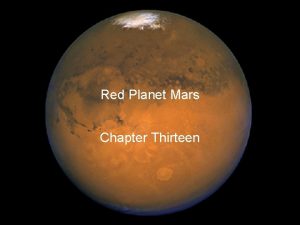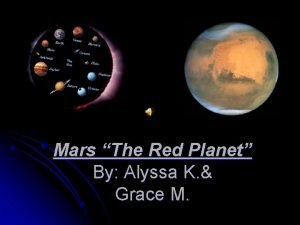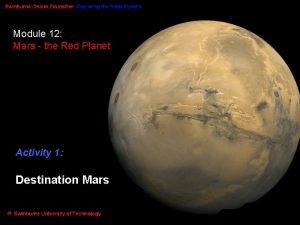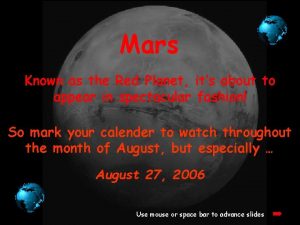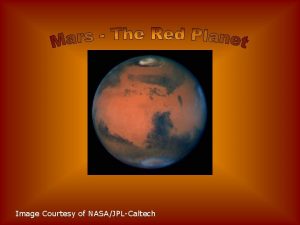Mars THE RED PLANET SunTemperature Mars is 1












- Slides: 12

Mars THE RED PLANET

Sun/Temperature Mars is 1 ½ times farther away from the Sun than Earth is. This makes Mars much colder than Earth. The temperature of Mars rarely rises above freezing!

Seasons Martian seasons last 2 times as long as Earth One Martian year=687 Earth Days Martian days are called “SOLS” One Martian year= 669 sols

Radiation is the transfer of energy in the form of waves or sub-atomic particles. On Earth, we are protected from space radiation because of Earth’s magnetic field. Mars has a thin atmosphere and no magnetic field. Radiation levels are twice as high on Mars than on Earth. Scientists are working on products to help shield astronauts from radiation they will encounter if and when they visit Mars.

Atmosphere & Oxygen The air of Mars is mainly carbon dioxide (95%). Only 0. 1% of air is oxygen. This means there is no oxygen to breathe on Mars. Earth’s atmosphere is a mixture of nitrogen, oxygen, and trace gases that include water vapor.

Atmospheric Pressure Mars’ atmosphere is very thin, only 1/100 of Earth’s surface pressure. In other words, Earth is 100 times more dense than Mars. On Earth, we live under about 15 pounds of air (pressure). If you stood on Mars, you would only be under 0. 15 pounds of pressure.

Water Mars was once thought to be completely dry, but scientists who study Mars have discovered that water does exist, especially during Mars’ warmer months. Also, how do you think the water doesn’t stay frozen when it is so cold there? Well, Mars is very salty, and we know that salt lowers the freezing point for water, so the water is able to run even in frigid temps. The question is: Where does the water come from? Scientists believe there may be porous rocks holding water below the surface (like an aquifer!)

Soil The soil on Mars is toxic, due to a chemical in the soil called Perchlorate, a salt made up of chlorine and oxygen. This would make it very difficult to grow plants on Mars.

Wind & Dust Mars has a reddish-brown dust, which is blown all around by the wind. The wind speed on Mars increases to 50 -100 meters per second during dust storms. Sometimes the entire planet is covered in dust storms. This is why Mars is called “The Red Planet. ”

Gravity is a force that causes 2 objects to pull towards each other. It holds us on Earth, and holds planets in orbit around the Sun. Mars has 1/3 the gravity of Earth. (This means you could jump 3 times as high there!) We already know that astronauts lose muscle and bone mass in microgravity…not quite “zero gravity”…and exercise 2 hours a day to fight this. What would people have to do if they lived on Mars to combat the effects of 1/3 the gravity we have on Earth?

Landforms on Mars Volcanoes ◦ Olympus Mons is a shield volcano (the largest in the solar system!) that is about the size of the state of Arizona. ◦ Think about why it could be so big…hint: The crust of Mars does not move like Earth’s crust (no tectonic plate movement there) Craters ◦ The Gusev Crater was probably once a water source, most likely a lake. Canyons ◦ Valles Marineris is bigger than the Grand Canyon. ◦ It is 2, 000 miles long!

Sources http: //mars. nasa. gov/allaboutmars/facts/#infographic https: //www. theguardian. com/science/2015/sep/28/nasa-scientists-find-evidence-flowingwater-mars http: //www. slate. com/articles/technology/future_tense/2015/04/perchlorate_in_martian_soil _the_chemical_that_could_be_dangerous_to_astronauts. html http: //mars. jpl. nasa. gov/gallery/atlas/olympus-mons. html http: //science. nasa. gov/science-news/science-at-nasa/2003/30 dec_gusevcrater/
